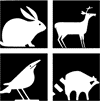Wildlife Damage Management, Internet Center for
Date of this Version
2005
Document Type
Article
Abstract
Deer-vehicle collisions (DVCs) impact the economic and social well being of humans. We examined large-scale patterns behind DVCs across 3 ecoregions: Southern Lower Peninsula (SLP), Northern Lower Peninsula (NLP), and Upper Peninsula (UP) in Michigan. A 3 component conceptual model of DVCs with drivers, deer, and a landscape was the framework of analysis. The conceptual model was parameterized into a parsimonious mathematical model. The dependent variable was DVCs by county by ecoregion and the independent variables were percent forest cover, percent crop cover, mean annual vehicle miles traveled (VMT), and mean deer density index (DDI) by county. A discriminant function analysis of the 4 independent variables by counties by ecoregion indicated low misclassification, and provided support to the groupings by ecoregions. The global model and all sub-models were run for the 3 ecoregions and evaluated using information-theoretic approaches. Adjusted R2 values for the global model increased substantially from the SLP (0.21) to the NLP (0.54) to the UP (0.72). VMT and DDI were important variables across all 3 ecoregions. Percent crop cover played an important role in DVCs in the SLP and UP. The scale at which causal factors of DVCs operate appear to be finer in southern Michigan than in northern Michigan. Reduction of DVCs will likely occur only through a reduction in deer density, a reduction in traffic volume, or in modification of sitespecific factors, such as driver behavior, sight distance, highway features, or speed limits.



Comments
Published in Proceedings of the 11th Wildlife Damage Management Conference. (D.L. Nolte, K.A. Fagerstone, Eds). 2005.